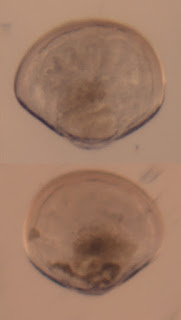Quiescence
 |
| Bivalve veligers (baby clams). The top individual was starved, and the bottom individual was fed for 48 hr. Photos by Kharis Schrage. |
So are larvae in the polar night quiescent? I wouldn't blame them if they were. I mean, it's pitch black outside, and there's no food. Why not just go dormant until the spring bloom?
One of the main goals Kharis and I had for this trip is to figure out whether larvae in the polar night are quiescent, patiently waiting until the sun comes back and there's food available. Quiescent larvae wouldn't do much - just kind of drift around. They wouldn't eat, and they certainly wouldn't metamorphose and settle.
To test our hypothesis, we conducted feeding and settlement assays with our larvae. We starved some larvae by putting them in super finely filtered seawater (0.2 μm). We kept others in a solution of phytoplankton that we brought with us. Two days later, we put them under the microscope to see if they had eaten anything. The shells and bodies of our larvae are pretty clear, so we can see straight through to their guts.
Do you think the larvae ate any phytoplankton? Check out the photos at the right side here. The top one was starved, and the bottom one was fed phytoplankton. Look at how different the colors of their guts are! The bottom one is much darker, and you can even see a dark streak that I think is its intestine. When provided with phytoplankton, the larvae definitely eat!
Next, we tested whether the larvae could settle. Settlement is a big deal in the life-history of an invertebrate. They completely change their habitat, body structure, and diet. Like a caterpillar becoming a butterfly, settlement involves a complete reorganization of their tissues - a metamorphosis. Settlement is energetically very expensive, so we thought maybe larvae would avoid settling in the polar night.
 |
| That, my friends, is a newly-settled bryozoan! Photo by Kharis Schrage. |
The polar night is a time of high biological activity. And larvae are not quiescent - not in the least.
Comments
Post a Comment